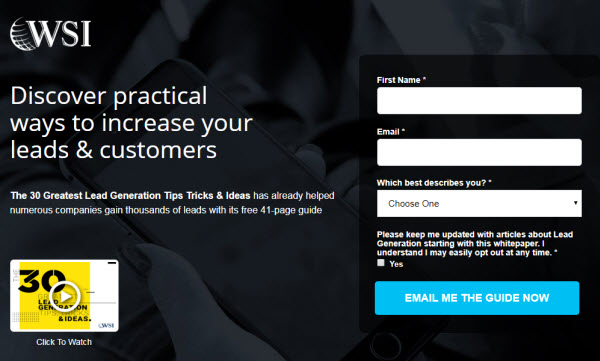The most effective sales content addresses what your customers care about, not what you care to tell them. Good content that moves the sales needle doesn’t just inform, it builds trust. And, nothing builds trust more than honesty.

Content that Addresses the Bad as Well as the Good
Nothing builds credibility more than openly addressing potential pitfalls and issues alongside your key selling points. It’s this perceived openness and honesty that builds credibility and commands authority. Openly addressing the negative serves to validate the positive. Think of it like seeing a few mediocre reviews alongside all your 5-star reviews. A few 3-star reviews here and there will only validate the 5-star reviews.
Content that Discusses Money, Costs, and Pricing
When I go to a restaurant and see “Market Price” on the menu, I know from experience that’s code for “expensive”. Now I have the dilemma of asking “how much” and taking the risk that I’ll look like a cheapskate when I choose something else, or just crossing my fingers and ordering it.
I’ll probably order something else. Why? Because they caused doubt, they’re making doing business with them risky…or at least uncomfortable. Content that openly discusses money, costs, pricing, rates, etc. alleviates doubt and moves the conversation forward.
You may not be able to address actual prices in Euros, but you can certainly address the cost drivers, and in some circumstances, even provide a range of pricing.
If your customers have a basic understanding of your pricing after reading your content, and still pick up the phone, you know that they have somewhat already pre-qualified themselves.
Content that is Willing to Turn Customers Away
I can assure you that not every customer is going to be a good fit. This is a good thing. It helps potential prospects avoid spending time on solutions they can’t afford and allows your sales team to focus on opportunities where they can truely help. The key is to avoid the mutual pain and get that out in front.
The question is how do we help “pre-qualify” the prospect with the content that we write?
A piece of written content (or a video) with titles like “Are We a Good Fit for You?” or the more intriguing “Who We are NOT a Good Fit For” not only raises curiosity but sets upfront expectations.
Customers who recognize that they may not be a good fit may self-opt-out before causing too much damage. Conversely, customers who can visualize themselves as the elite who are qualified to work with you probably have one step down the sales funnel.
Video Content that Simulates the Buying Experience
The limitation of the Internet has always been the lack of tensile experience, the ability to touch and feel and physically get a sense of your surroundings.
No, you can’t touch that garment on a website, smell that food, or hold that nicely designed packaging in your hand, but high-quality photos and videos that are designed to replace (or facilitate) the buying experience are the next best thing. For example, videos of regular people test driving a car. You may not be behind the wheel, but you can see their expressions and exhilaration.
Video Strategies that Move the Sales Needle
The 80% Video: According to Marcus Sheridan (thesaleslion.com) 80% of questions consumers ask are the same. Get your sales team together and write down the top 7 questions they get from their prospects. Then create an individual video for each question and put it on the appropriate page on your site.
Then “mash” them up into one video and send the video out before every initial sales call. The prospect will already know you before they talk to you, and they’ll already have their most important questions answered.
Bio Videos Used with Email: This one’s a gem. Why be satisfied with the typical logo, name and phone number on your email signature when you can embed a video introduction of yourself?
You don’t have to re-write Gmail or Outlook to make that work. There’s a program called WiseStamp, with free and paid versions that allow you to customize your email signatures on all the major email clients. Add a 60-90 second video talking about what you do, why you love your job, the problems that you solve and maybe something personal. Sheridan says some people get over a 100 video views per month using this video signature.
Product/Service Page Videos: This one’s a bit obvious, if not underused. Every product or service page should have its video. Could be a demonstration, consumers using your product or a testimonial.
Landing Page Videos: Driving traffic to your landing pages is one thing, getting a consumer to fill out that form is a bit more challenging. Consider a short video to alleviate that uncertainty before they have second thoughts and bounce.
Here is a an example of one of our landing pages where we use a video to encourage visitors to complete the form. If you click on the video thumbnail it opens and plays in a pop-up window
The average conversion lift for landing pages with video is about 80%. Use the videos to set expectations and alleviate fears or any negative sentiments that may prevent the visitor from signing up. For example “This is what this eBook is all about, and this is how much you are going to hear from us…. etc”
Case Study Videos: Not testimonials. Don’t just talk about what went great, but also what went wrong and how you solved it. Hearing a little bit from your customer wouldn’t hurt either. If you do use charts and graphs, keep them simple and large enough to be viewed on the small screen of a smartphone.
Who We’re Not Good For: Remember that part about “Content that is willing to turn customers away”? A simple Talking Head video explaining who your service or product is, and isn’t good for, shows confidence and transparency. Besides, reverse psychology is fun!
Some closing points to consider:
- They must See us before we see them.
- They must Hear us before we hear them.
- They must Know us before we know them.
Be honest, be transparent…be successful.


Stay Connected